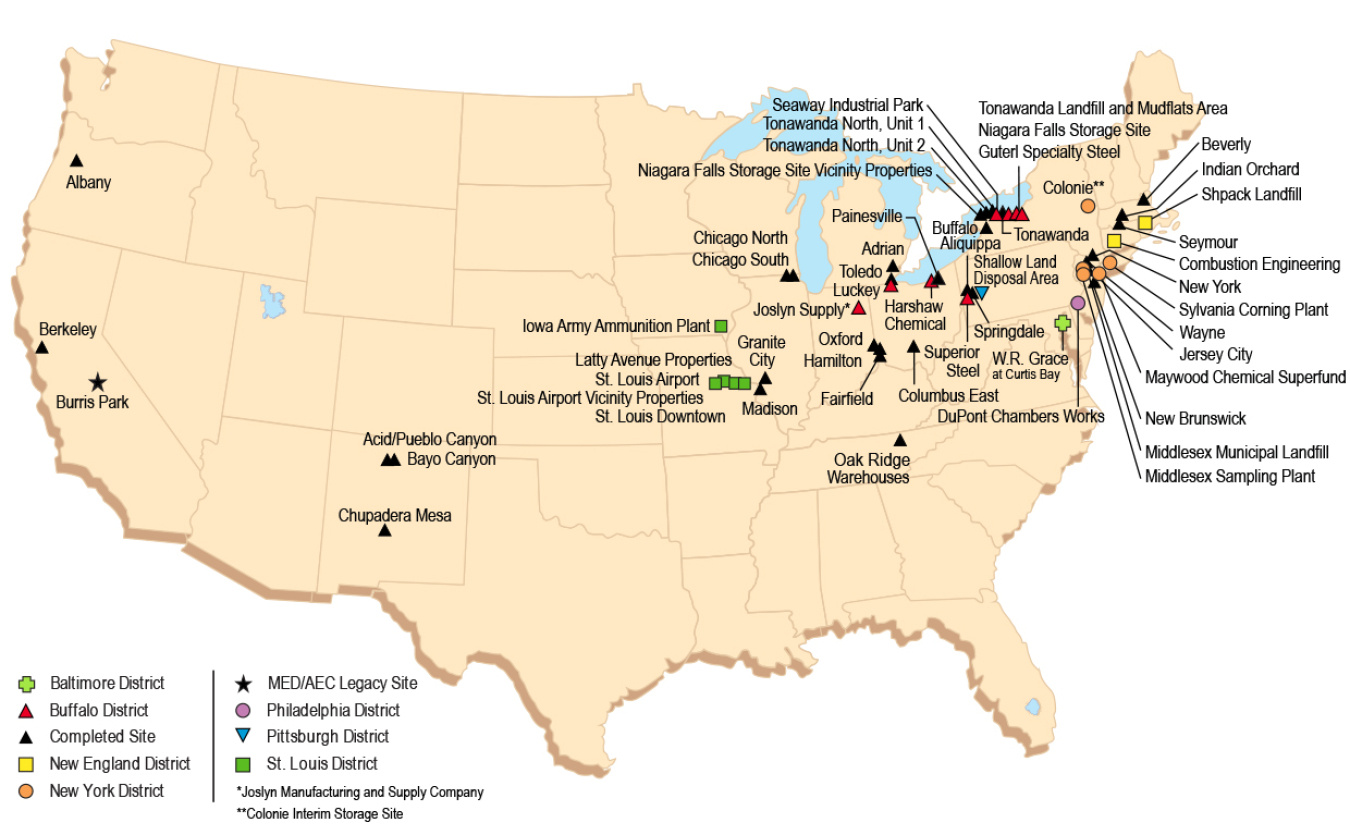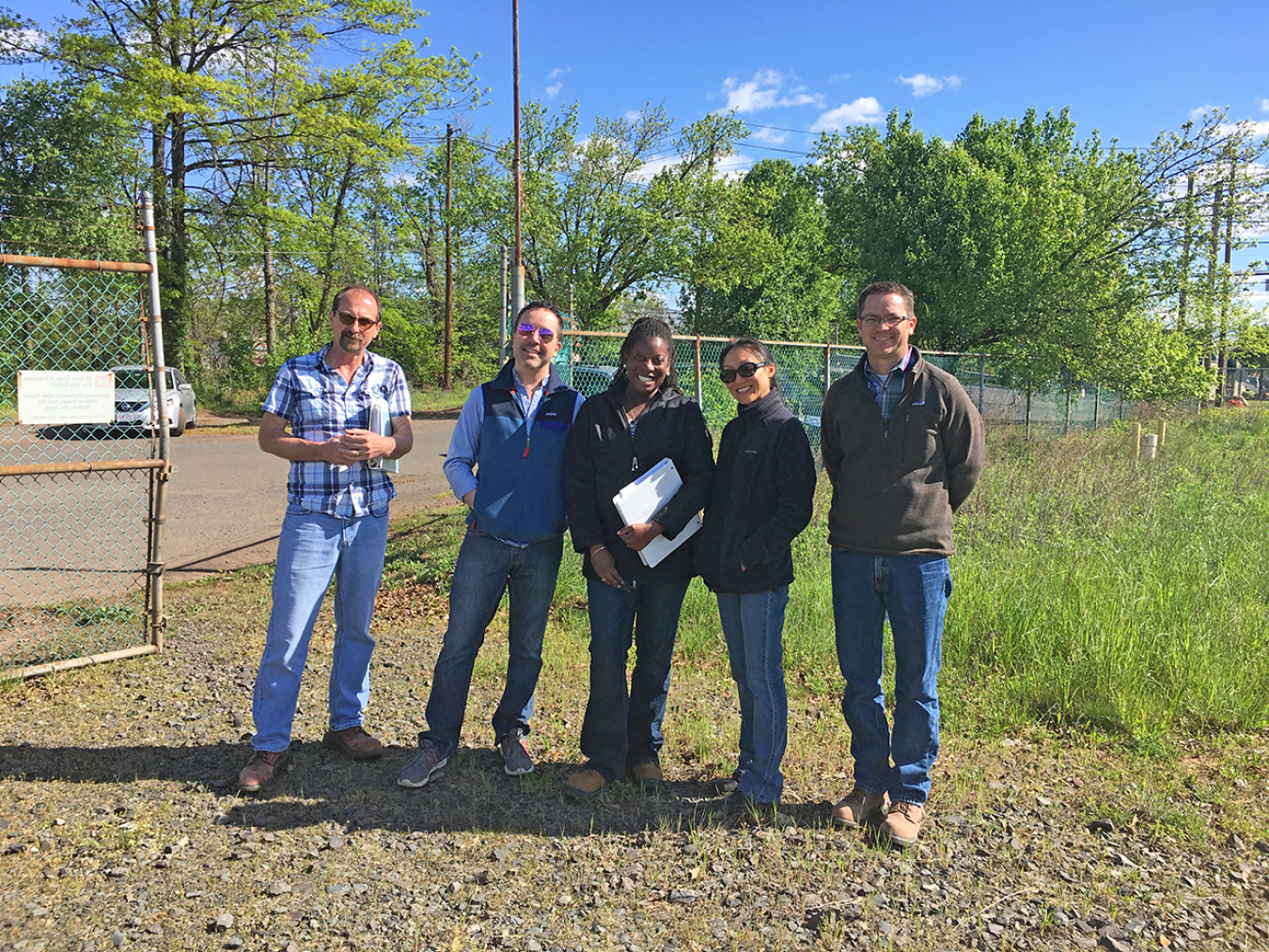FUSRAP Collaboration Between LM and USACE
June 19, 2017A collaborative approach is taken between the U.S. Army Corps of Engineers (USACE) and the U.S. Department of Energy (DOE) Office of Legacy Management (LM) to ensure a seamless transfer of Formerly Utilized Sites Remedial Action Program (FUSRAP) sites from USACE to LM. The approach focuses on three areas: expanded face to face interaction, increased LM/USACE dialog as partners, and teamwork by way of focused working groups.
Program overview
LM sites fall under a variety of regulatory or functional categories, one of which is FUSRAP. DOE established FUSRAP in 1974 to remediate sites where radioactive contamination remained from U.S. Army Corps of Engineers Manhattan Engineer District (MED)—or Manhattan Project—and early U.S. Atomic Energy Commission (AEC) operations. A Memorandum of Understanding between USACE and DOE was established in 1999 to define the roles of each agency in administering and executing FUSRAP. USACE has responsibility for FUSRAP sites designation and remediation. USACE then retains responsibility for the site for a two-year transition period after cleanup. DOE is responsible for identifying the eligibility of new FUSRAP sites and for long-term stewardship of the remedy after the transition period.
USACE has transferred long-term stewardship responsibilities for six FUSRAP sites to LM since it was established in 2003. It is anticipated that in the next five years USACE will complete remedial activities and transfer stewardship responsibilities for eight additional FUSRAP sites to LM (Colonie Interim Storage Site, Combustion Engineering Site, DuPont Chamber Works, Iowa Army Ammunition Plant, Middlesex Sampling Plant, Shpack Landfill, St. Louis Downtown Site, and W.R. Grace at Curtis Bay). Stewardship responsibilities for many of these incoming sites will be greater than sites currently under LM stewardship.
Expanded Face to Face Interaction
In October 2015 LM and USACE attended a joint program meeting in Omaha, Nebraska. This event set the cornerstone for increased LM and USACE collaboration. It was at this meeting that newer LM FUSRAP team members began fostering relationships with USACE project managers and the formation of working groups was discussed. Following this meeting LM and USACE have had routine meetings at the site, district, and program level, with a program-wide meeting scheduled for October 2017.
Collaboration is critical with 55 FUSRAP sites—23 active sites being remediated by seven USACE districts, and 31 completed sites and 1 MED/AEC legacy site under LM stewardship—spread throughout 16 states. Located across the country, LM and USACE project managers have limited opportunities to meet in person. One approach toward increasing face to face interaction is through attendance at conferences such as the RadWaste Summit and the Waste Management Symposia. In 2016 LM and USACE agreed to co-author a paper for the Waste Management Symposia entitled Transition and Transfer of Remediated FUSRAP Sites from USACE to US DOE for Long-Term Surveillance and Maintenance, which discussed the close coordination between LM and USACE throughout the transition process. A second initiative has been LM attendance at USACE public meetings for individual FUSRAP sites ready to transfer in the near term. The most recent USACE public meetings attended by LM were for the FUSRAP sites located in St. Louis, Missouri; Colonie, New York; and Luckey, Ohio. LM attendance at these meetings provided opportunities to gain insight on the community viewpoint and to begin fostering stakeholder relationships that exist at each FUSRAP site.

LM/USACE annual site visits to selected active FUSRAP sites create other face-to-face meeting venues. In May 2017 LM visited the Latty Avenue Properties, the St. Louis Airport Site, the St. Louis Airport Vicinity Properties, the St. Louis Downtown Site, Colonie, Maywood, the Middlesex Sampling Plant, and the Wolff-Alport eligible site.

Site visits enable LM to see firsthand the current status of remedial activities being performed, and provide an opportunity to meet with USACE and discuss site-specific details that LM can use for future long-term surveillance and maintenance planning.
Increased dialog as partners
With communication a key factor for success, LM management has increased the frequency and scope of conference calls between LM site managers and USACE project managers. Regularly scheduled conference calls are jointly attended by LM and USACE. When needed, calls with subject matter experts are used to promote discussion and transfer of information on specific topics at the site or USACE district level. Additionally, quarterly calls between the USACE national program manager and LM FUSRAP Team lead are conducted to discuss strategic objectives, as well as program goals.
Teamwork Through Focused Working Groups
LM recognizes that close collaboration with our USACE partners is essential to accomplishing our mission in an effective and efficient manner. This collaborative environment is most notable with the formation of joint working groups. Each working group is dedicated to a specific topic to 1) exchange subject information, 2) arrive at a consensus, and 3) define a path forward. Since their inception in 2016, there have been two specific working groups formed, with more anticipated in the future. The Real Property Working Group has successfully completed its objectives to develop a common understanding about real property issues as they apply to FUSRAP programmatic documents for site transition and transfer, and to develop real property site checklists for all active FUSRAP sites. The Data Management Working Group has just begun to meet and has goals to establish a common understanding of DOE and USACE district-specific data, records practices, and requirements as they apply to FUSRAP programmatic documents for site transition and transfer, as well as to establish methods to ensure accurate data transfer. Through the joint commitment between LM and USACE a successful outcome is also anticipated.
Conclusion
Joint efforts to expand opportunities for face to face interaction, increase dialog as partners, and work successfully as a team through focused working groups has resulted in more open lines of communication and a better understanding of each other’s needs when it comes to site transition and transfer. Expanded working group topics, quarterly conference calls, and continuing attendance of conferences, public meetings, and site visits are planned to further USACE and LM collaborative efforts and execute common mission goals.

